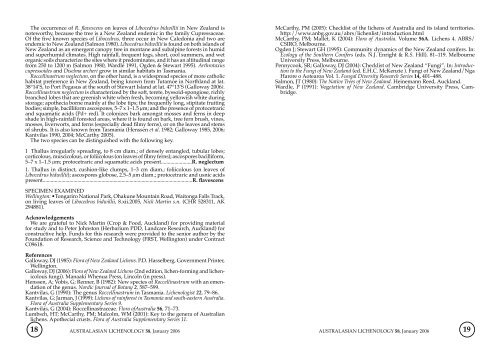(Ascomycota: Lecanorales). Taxon 53
(Ascomycota: Lecanorales). Taxon 53
(Ascomycota: Lecanorales). Taxon 53
You also want an ePaper? Increase the reach of your titles
YUMPU automatically turns print PDFs into web optimized ePapers that Google loves.
The occurrence of R. flavescens on leaves of Libocedrus bidwillii in New Zealand is<br />
noteworthy, because the tree is a New Zealand endemic in the family Cupressaceae.<br />
Of the five known species of Libocedrus, three occur in New Caledonia and two are<br />
endemic to New Zealand (Salmon 1980). Libocedrus bidwillii is found on both islands of<br />
New Zealand as an emergent canopy tree in montane and subalpine forests in humid<br />
and superhumid climates. High rainfall, frequent fogs, short, cool summers, and wet<br />
organic soils characterize the sites where it predominates, and it has an altitudinal range<br />
from 250 to 1200 m (Salmon 1980, Wardle 1991, Ogden & Stewart 1995). Arthrotaxus<br />
cupressoides and Diselma archeri grow in similar habitats in Tasmania.<br />
Roccellinastrum neglectum, on the other hand, is a widespread species of more catholic<br />
habitat preference in New Zealand, being known from Tutamoe in Northland at lat.<br />
38°14’S, to Port Pegasus at the south of Stewart Island at lat. 47°13’S (Galloway 2006).<br />
Roccellinastrum neglectum is characterized by the soft, terete, byssoid-spongiose, richly<br />
branched lobes that are greenish white when fresh, becoming yellowish white during<br />
storage; apothecia borne mainly at the lobe tips; the frequently long, stipitate fruiting<br />
bodies; simple, bacilliform ascospores, 5–7 x 1–1.5 µm; and the presence of protocetraric<br />
and squamatic acids (Pd+ red). It colonizes bark amongst mosses and ferns in deep<br />
shade in high-rainfall forested areas, where it is found on bark, tree fern brush, vines,<br />
mosses, liverworts, and ferns (especially dead filmy ferns), or on the leaves and stems<br />
of shrubs. It is also known from Tasmania (Henssen et al. 1982; Galloway 1985, 2006;<br />
Kantvilas 1990, 2004; McCarthy 2005).<br />
The two species can be distinguished with the following key.<br />
1 Thallus irregularly spreading, to 8 cm diam.; of densely entangled, tubular lobes;<br />
corticolous, muscicolous, or foliicolous (on leaves of filmy ferns); ascospores bacilliform,<br />
5–7 x 1–1.5 µm; protocetraric and squamatic acids present.......................R. neglectum<br />
1. Thallus in distinct, cushion-like clumps, 1–3 cm diam.; foliicolous (on leaves of<br />
Libocedrus bidwillii); ascospores globose, 2.5–5 µm diam.; protocetraric and usnic acids<br />
present................................................................................................................R. flavescens<br />
SPECIMEN EXAMINED<br />
Wellington: •Tongariro National Park, Ohakune Mountain Road, Waitonga Falls Track,<br />
on living leaves of Libocedrus bidwillii, 8.xii.2005, Nick Martin s.n. (CHR 528311, AK<br />
294881).<br />
Acknowledgements<br />
We are grateful to Nick Martin (Crop & Food, Auckland) for providing material<br />
for study and to Peter Johnston (Herbarium PDD, Landcare Research, Auckland) for<br />
constructive help. Funds for this research were provided to the senior author by the<br />
Foundation of Research, Science and Technology (FRST, Wellington) under Contract<br />
C09618.<br />
References<br />
Galloway, DJ (1985): Flora of New Zealand Lichens. P.D. Hasselberg, Government Printer,<br />
Wellington.<br />
Galloway, DJ (2006): Flora of New Zealand Lichens (2nd edition, lichen-forming and lichenicolous<br />
fungi). Manaaki Whenua Press, Lincoln (in press).<br />
Henssen, A; Vobis, G; Renner, B (1982): New species of Roccellinastrum with an emendation<br />
of the genus. Nordic Journal of Botany 2, 587–599.<br />
Kantvilas, G (1990): The genus Roccellinastrum in Tasmania. Lichenologist 22, 79–86.<br />
Kantvilas, G; Jarman, J (1999): Lichens of rainforest in Tasmania and south-eastern Australia.<br />
Flora of Australia Supplementary Series 9.<br />
Kantvilas, G (2004): Roccellinastraceae. Flora ofAustralia 56, 71–73.<br />
Lumbsch, HT; McCarthy, PM; Malcolm, WM (2001): Key to the genera of Australian<br />
lichens. Apothecial crusts. Flora of Australia Supplementary Series 11.<br />
18<br />
McCarthy, PM (2005): Checklist of the lichens of Australia and its island territories.<br />
http://www.anbg.gov.au/abrs/lichenlist/introduction.html<br />
McCarthy, PM; Mallet, K (2004): Flora of Australia. Volume 56A. Lichens 4. ABRS/<br />
CSIRO, Melbourne.<br />
Ogden J; Stewart GH (1995): Community dynamics of the New Zealand conifers. In:<br />
Ecology of the Southern Conifers (eds. N.J. Enright & R.S. Hill), 81–119. Melbourne<br />
University Press, Melbourne.<br />
Pennycook, SR; Galloway, DJ (2004): Checklist of New Zealand “Fungi”. In: Introduction<br />
to the Fungi of New Zealand (ed. E.H.C. McKenzie ). Fungi of New Zealand/Nga<br />
Harore o Aotearoa Vol. 1. Fungal Diversity Research Series 14, 401–488.<br />
Salmon, JT (1980): The Native Trees of New Zealand. Heinemann Reed, Auckland.<br />
Wardle, P (1991): Vegetation of New Zealand. Cambridge University Press, Cambridge.<br />
AUSTRALASIAN LICHENOLOGY 58, January 2006 AUSTRALASIAN LICHENOLOGY 58, January 2006<br />
19

















